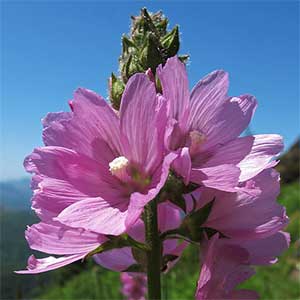Sidalcea keckii
Sidalcea hirtipes
Keck's checkerbloom
bluff mallow, bristly-stem checker-mallow, bristly-stem checkerbloom, hairy-stem checkermallow
single, erect, sometimes branched distally, solid, short-stellate-puberulent and long, soft bristly-hairy, distally with multicellular trichomes intermixed, hairs erect.
several, scattered, erect, arising from rhizome apices, usually slightly hollow, densely, harshly bristly-hirsute, hairs stiff, pustular, simple, forked, or stellate, often 2–2.5 mm.
cauline, 3–5 per stem;
stipules linear-filiform, undivided or rarely few-divided in robust plants, 3–5 × 1 mm;
petiole 2–4.5(–6) cm, usually 1–2 times as long as blade;
blades: proximalmost orbiculate, unlobed, 1–2.5 × 1–2.5 cm, base cordate with narrow sinus, margins crenate, apex rounded;
other proximals rounded, unlobed or shallowly palmately 7–9-lobed, 2.5–4.8(–6) × 2.5–4.8(–6) cm, margins coarsely crenate, sinus wide to narrow, surfaces stellate-hairy;
distals gradually reduced, orbiculate, more deeply 3-lobed, 1.5–2.5 × 1.5–2.5 cm, lobes obovate, apically widened to nearly truncate and narrowed to base, margins entire, apex 2–5-toothed, teeth subequal.
basal and cauline;
stipules linear-subulate, 6–8 × 1–1.5 mm;
petioles of proximal leaves 20–30 cm, 3 times as long as blades, reduced distally to 1/2 times as long as blades;
blades: basal and proximalmost orbiculate to reniform, shallowly 5–9-lobed, 10–15 × 10–15 cm, thick, base narrowly cordate, lobe margins coarsely crenate-dentate, apex rounded, surfaces coarsely hirsute, hairs stiff;
distal orbiculate, deeply palmately 5–7-lobed, incised ± to base, lobes sometimes lobed again, base cuneate, apex acute, deeply 2–3-toothed, surfaces long-hirsute or with 2–4-rayed, stellate hairs abaxially.
erect to ascending, usually open, calyces not overlapping except possibly in bud, unbranched or infrequently branched, 5–12-flowered per branch, not especially elongate, usually 1-sided, 5–10 cm, to 5–15 cm in fruit, 1/2 times plant height;
bracts linear-filiform, undivided or rarely few-divided in robust plants, (3–)7–11 mm, longer than pedicels, usually much shorter than calyx, not involucrelike, densely stellate-hairy and pilose-hirsute.
erect, spiciform to subcapitate, dense, calyces usually conspicuously overlapping in flower and sometimes in fruit, proximals usually long-pedunculate, unbranched or branched, 20+-flowered, 10+ flowers usually open on spike at same time, not interrupted, not 1-sided, usually to 8 cm, usually not elongate but sometimes slightly elongated in some populations and to 20 cm in fruit;
bracts paired or single, linear, distal undivided, proximal distinct to base, 6 mm, mostly slightly longer than pedicels.
2–4 mm, to 5–6 mm in fruit;
involucellar bractlets absent.
1–3(–5) mm;
involucellar bractlets absent.
bisexual;
calyx 8–10 mm, to 11–14 mm in fruit, lobe base within with conspicuous, purplish spot 1–2 mm wide, hairy, hairs glandular and non-glandular, multicellular as in inflorescence;
petals dark pink, without pale veins, with or without reddish basal spot, 10–22(–26) mm;
filaments connate to apex of tube;
staminal column 3–5 mm, hairy, hairs relatively long, simple;
anthers white;
stigmas 4 or 5.
bisexual or unisexual and pistillate, plants gynodioecious;
calyx often purple tinted, 9–11 mm, to 11–16 mm in fruit, margins ciliate, hairs 1–2 mm, surfaces finely stellate-hairy at base and with coarser, longer, simple and stellate hairs apically;
petals usually pale pink to rose-lavender, rarely white, slightly or not pale-veined, (9–)10–21 mm, pistillate often 9–14 mm;
staminal column 5–7(–10) mm, hairy;
anthers white;
stigmas 5–10.
1.5–2 mm.
2.5–3.5 mm.
5–7 mm diam.;
mericarps 4 or 5, usually tinted pink when fresh, 3–4 mm, usually glabrous, back reticulate-veined, pitted, with prominent midvein, mucro absent but with 1–5 minute bristles in its place.
7–8 mm diam.;
mericarps 5–10, 3.5–4 mm, glabrous or sparsely stellate-puberulent, roughened, prominently reticulate-veined, sides rugose and pitted, back less so, mucro 0.6–0.8 mm.
= 60.
Sidalcea keckii
Sidalcea hirtipes
Sidalcea keckii, federally listed as endangered, was once thought to have been extirpated (S. R. Hill 1993); it was rediscovered in 1992. It appears to have occurred historically in at least seven counties; extant populations are thought to be very few. It is found in the southern inner North Coast Ranges in Colusa, Napa, Solano, and Yolo counties, and in the Sierra Nevada foothills in Fresno, Merced, and Tulare counties. It is closely related and similar to S. diploscypha and is often mistaken for that species; differences between the two are discussed under 8. S. diploscypha. Some plants of S. keckii in Colusa, Solano, and Yolo counties have divided bracts like those of S. diploscypha. Sidalcea keckii is vulnerable to agricultural and residential land development.
Of conservation concern.
(Discussion copyrighted by Flora of North America; reprinted with permission.)
Of conservation concern.
Sidalcea hirtipes is uncommon and known from Clatsop, Lincoln, and Tillamook counties in Oregon and Clark, Lewis, and Wahkiakum counties in Washington. Its elevation and habitat vary, and it seems as much at home on steep coastal cliffs as in more inland, historic prairies and mountain meadows. Populations can appear to be large because of the long-rhizomatous and clonal nature of the plants; they are few and local. It is threatened by grazing, loss of habitat, fire suppression, road construction and maintenance, and changes in hydrology. It is a candidate for listing in Oregon and has been listed as endangered in Washington. Sidalcea hirtipes is characterized by its coarse indument of bristle hairs, its generally compact spikelike inflorescences, its relatively few, large, erect, hirsute leaves, and, especially, its extensive, coarse rhizomes. The inflorescences in some populations are elongated in fruit; its range, hirsute indument, and thick leaves along with coarse rhizomes help to distinguish it from other species. Stem internode length varies depending on habitat, as in many other Sidalcea. Molecular data suggest a relationship among S. hirtipes and S. asprella, S. celata, and S. gigantea (K. Andreasen and B. G. Baldwin 2003).
(Discussion copyrighted by Flora of North America; reprinted with permission.)
